My kayak knifed through warm Gulf waters as fast as it could run. We had outfitted our boats with 10-foot masts, outrigger arms on inflatable sponsons, and 2-foot-long leeboards, happy to be plying the wind instead of slogging by paddle. When I shook out the sail reef for more speed, the sponsons skipped over waves like thrown stones. Holding tight to shore, I adjusted my course by tapping the rudder pedals to dodge sharp mangrove stumps. I briefly closed my eyes, happy to have escaped winter, immersed in a sense of mastery as I inhaled the rotten-egg fecundity of the Everglades. America’s most magnificent swamp stretched limitlessly before me.
I had never seen so many different bird species in one place, often clutching fish in their talons or beaks; squadrons of pelicans, teams of ducks, musterings of storks, and herds of curlews. All morning long, stingrays leapt and splashed into the sea.
Sailing downwind, I veered ever closer to a long, uninhabited white-sand beach, catching short rides as the shallows lumped the water up into surf. But as I rounded a point onto flatter water, a murky wave came off shore, bisecting my point of sail: I had startled a crocodile, basking in the sun. With powerful, snakelike tail undulations, the beast cut directly beneath the kayak and sent a wave across my chest as it shimmied seaward, visible only by its wake. This all happened too quickly to be properly scared, but my fingers trembled with adrenaline. The world’s largest reptile had just given me the equivalent of a poolside cannonball soaking.
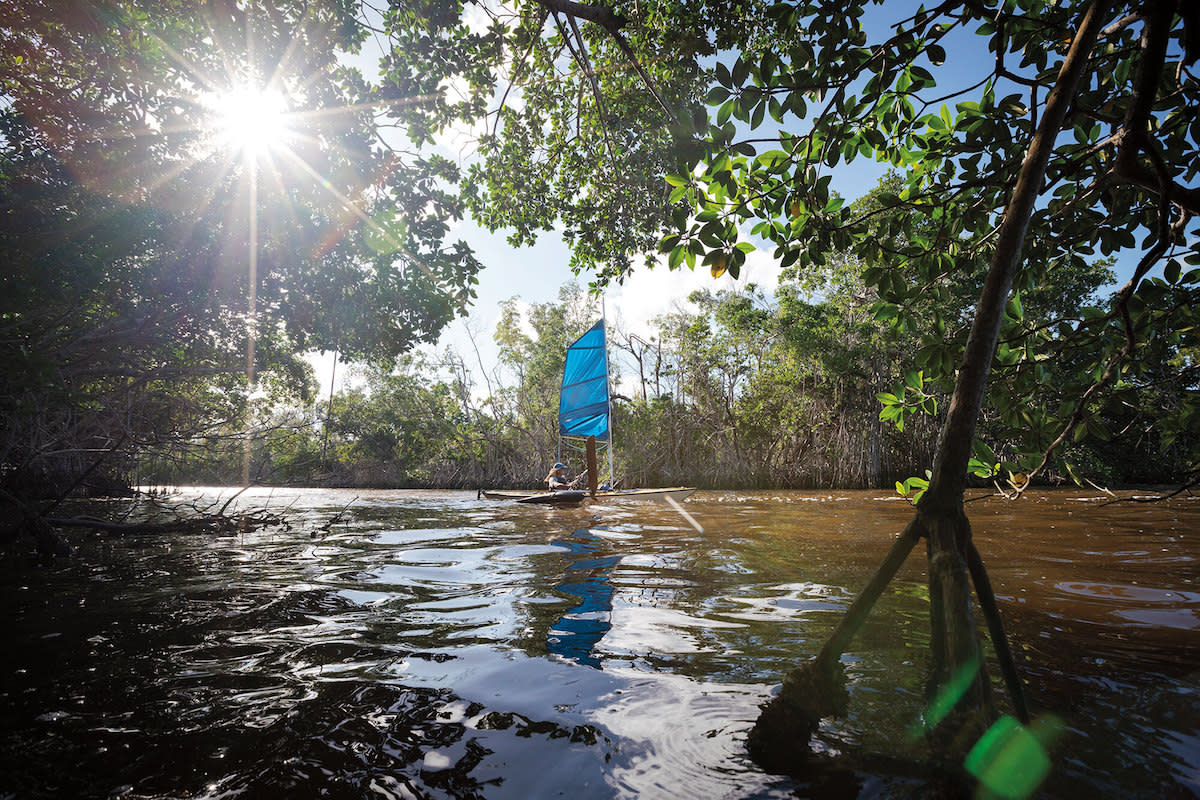
I came to the Everglades to see if America’s most endangered national park had taken its last breath. In 1947, the same year the park was established, the journalist Marjory Stoneman Douglas—who became renowned for her efforts to save this place—published The Everglades: River of Grass. In the final chapter, “The Eleventh Hour,” she wrote “the Everglades were dying.” She described a once-giant-yet-diminished marsh, denied more than half of its life-giving water, cooked by unprecedented wildfires, and polluted by sugar plantations.
In 1966, I first visited the Everglades during a field trip with my Boca Raton grade school and the place—filled with God-only-knows-how-many bugs—spoke to me. A ponderous river ran across and underneath the swamp, watering over a thousand different plants, haunted by legendary creatures like the Florida panther. I saw more than a few of the 360 different colorful and long-legged birds that waded alongside alligators and crocodiles—the only place in the world where these two reptiles cohabitate.
The park itself stretches over 1.5 million acres—as big as Delaware, but with no roads leading through its two ends, just a wilderness of water filled with unexpected, subtropical critters amid an extraordinary panoply of nine different habitats. For nearly a half-century (until Death Valley was established), it remained the largest national park in the Lower 48.
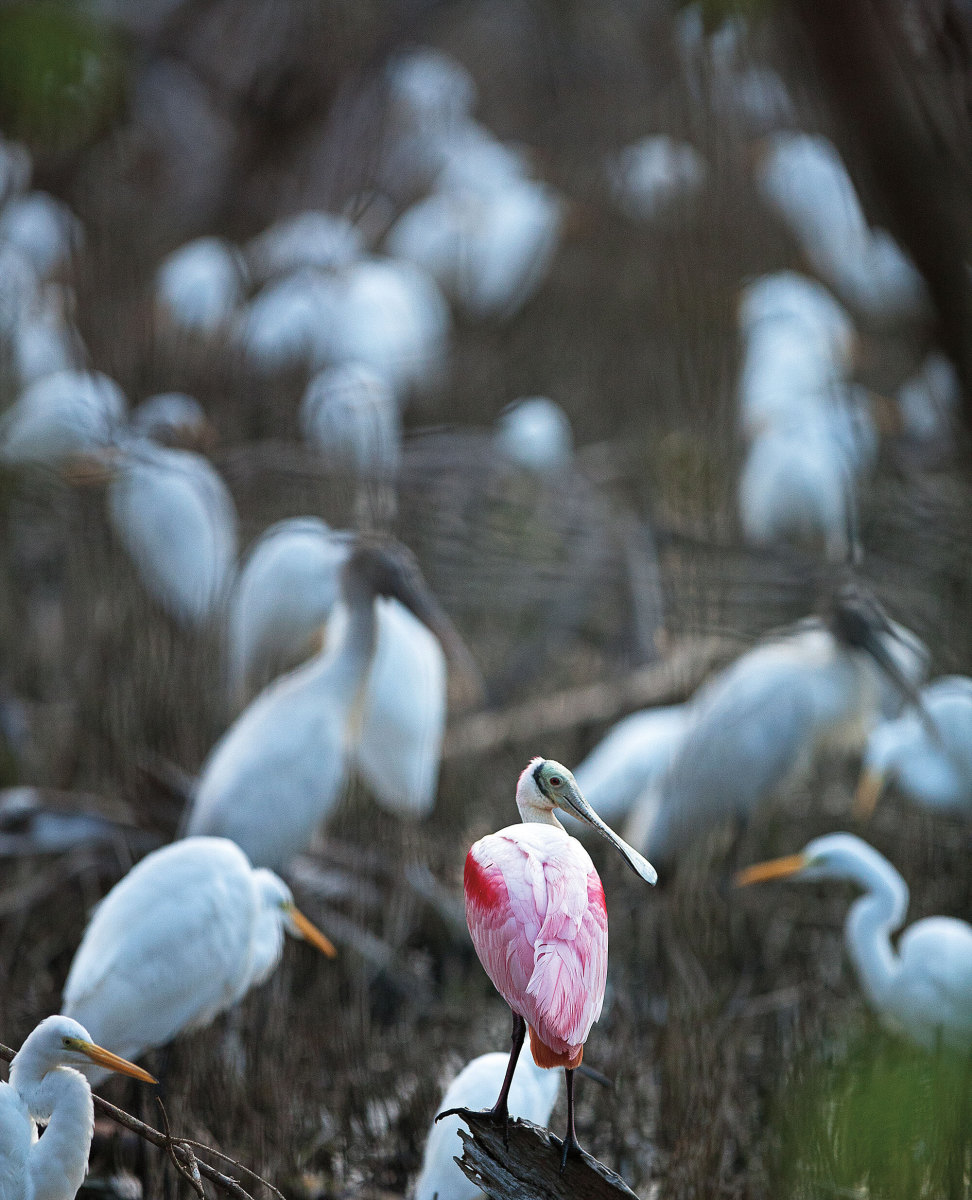
As a 10-year-old in need of adventure and male mentorship, I watched an airboat skim through a vast sawgrass prairie and imagined poachers chasing wildlife—conjured up by my favorite TV show Everglades, featuring larger-than-life park ranger Lincoln Vail.
Along with that Everglades visit, those indelible adolescent years living with my grandmother while sailing and fishing in South Florida set a hook: I would become an avid bird-watcher, a live-aboard sailor and fisherman, a national park ranger, and a lifelong explorer. In the meantime, the ancient Everglades—and Florida itself—continued its precipitous decline.
South Florida’s population grew to over 6 million as the 60-mile-wide by 100-mile-long River of Grass continued to dry up. In order to develop the coasts and farmlands, the U.S. Army Corps of Engineers was tasked with draining the swamp with canals. Since 20th-century bureaucracies gravitated toward development-oriented flood control rather than environmental restoration, few understood or cared that the Corps was draining the lifeblood of the Everglades.
That is until 2000, when Congress approved the Comprehensive Everglades Restoration Plan (CERP) to bring desperately needed freshwater back to the wilted national park through an expensive, albeit visionary, water engineering plan. And ironically, the ambitious environmental restoration project was handed to the same Army Corps of Engineers that drained the swamp to begin with. The other irony, of course, is that this massive effort to re-water a rapidly drying ecosystem runs counter to the park’s other existential threat: ever-rising sea levels.
A half-century after my first visit, I returned to see if these mystical wetlands still had the same capacity to inspire me. In late February, I embarked on a full kayak crossing of the park with three buddies—Greg Bellware, Robin Deykes, and Chris Korbulic—starting from the mouth of one of the drainage canals. Or, what would have been its terminus. While this waterway had originally been built to divert floods and provide access for boaters, rising sea levels forced this and other park canals to be dammed to keep saltwater out of freshwater wetlands. In nearby Key West over the last century, NOAA has recorded a 9-inch ocean rise caused by climate change.
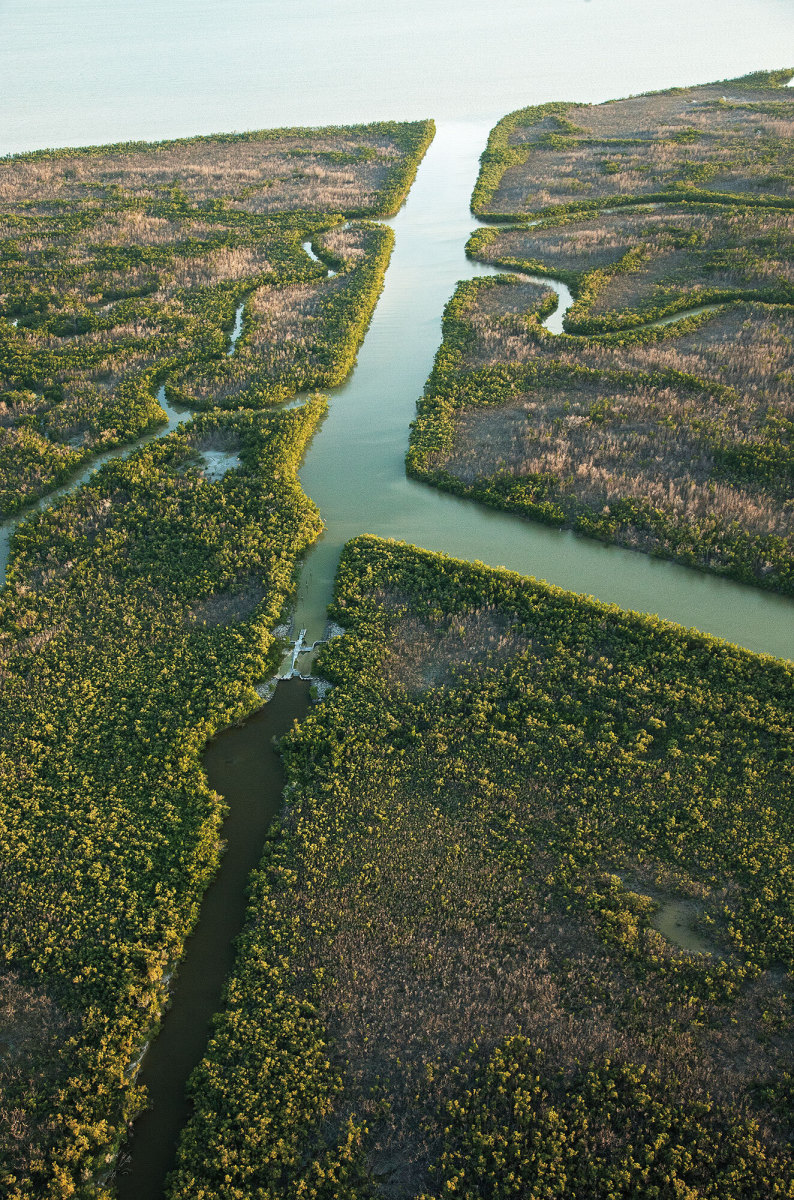
We began at the end of the road, on the southern tip of the Florida peninsula, launching alongside park tourists ogling manatees and alligators off the boat ramp by the Flamingo general store. From this 50-foot-wide dammed canal, our route would take us from the southern park, through the Wilderness Waterway, and out into Gulf of Mexico waters as we worked our way 99 miles north to Everglades City. Beyond the dam behind us, the island-dotted Florida Bay estuary—no longer recharged by adequate amounts of freshwater—had recently gone hyper-saline, killing most of the underwater seagrass and destroying fish habitat.
The resulting economic fallout for fishing guides is only a small part of the park’s mounting challenges. There is still damage from Hurricane Irma in 2017, two visitor centers under repair, a maintenance overload and, as in many underfunded national parks, a lack of staffing to manage the myriad operational issues. The park was open during last year’s government shutdown, and although no significant damages were reported, this end of the park would be entirely shut down during the coming COVID-19 pandemic.
Two hours later, Greg, Robin, and I caught up to Chris in Coot Bay. With a breeze chopping the water, we left the protected canal, reefed our sails, pushed down the leeboards, and sped across the wind. Above us, an endangered kite streamed its forked tail like two trailing legs, tracing the rich, green shoreline from the air in search of apple snails.
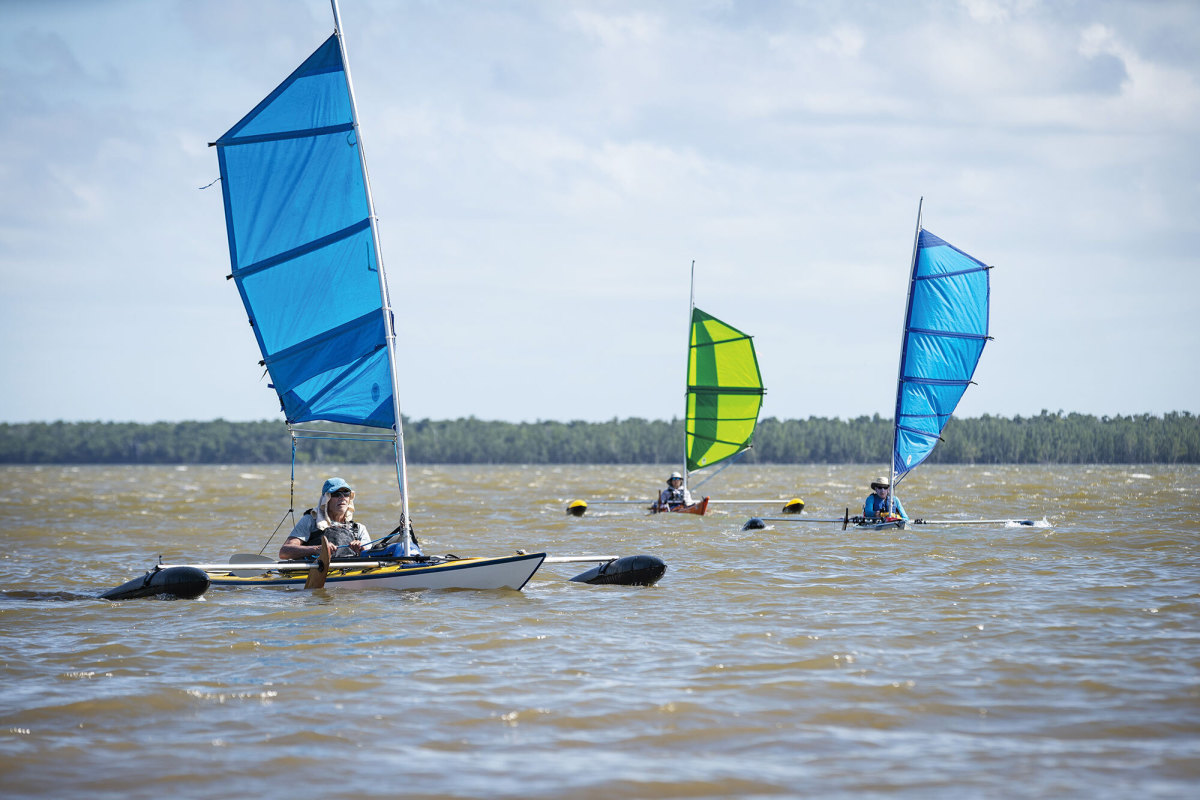
A veritable jungle of salt-tolerant mangroves—the largest contiguous protected forest of its kind in the Western Hemisphere—surrounded us. The hardy trees also act as a coastal barrier and shelter for numerous animals and less salt-tolerant inland plants. Yet the smell of hydrogen sulfide gas wafting out of the forest is an exigent reminder of the decaying mangroves that lie beneath the surface, many of which were killed in Hurricane Irma nearly three years ago. Along with more frequent and powerful storm surges, the ocean is rising on this flat coastline up to three times faster than that of the global average. As saltwater breaches the mangroves, it reaches other freshwater flora such as the park’s dominant 6-foot-tall sawgrass. These plants grow in the carbon-rich, peat soil backbone of the Everglades, holding it in place, while also facilitating the creation of new soil. But as saltwater exposes and kills freshwater plant roots, that backbone collapses. Now, brackish ponds are slowly subsuming the sawgrass prairie, turning the Everglades as salty as a half-empty margarita goblet. To a South Florida ecologist, peat collapse holds the same potential for ruination as the droughts, wildfires, melting glaciers, and thawing permafrost found in other national parks.
Despite the smell, the tentacle-rooted mangroves in the Wilderness Waterway appeared intact, though impossible to tent in. So, as the sun dipped into the Gulf of Mexico, the light tinged saffron, and we steered up a narrow channel of the tide-driven South Joe River toward our permitted chickee tent platform.
Our floating campsite held an 8-foot-tall portable toilet and two simple, open-air roofs. With the motorboat-designed platform several feet above the water, offloading a tippy kayak demanded the coordination and poise of a nimble athlete. As Greg—a veteran of countless triathlons—struggled to wrest gear from his tiny rear hatch, he fell backward into the water with our dinner bag, his shouted expletives a scant defense against hungry alligators. Eventually, we chased down our mac and cheese while watching an anhinga perch statuesquely, hanging its wings out to dry.
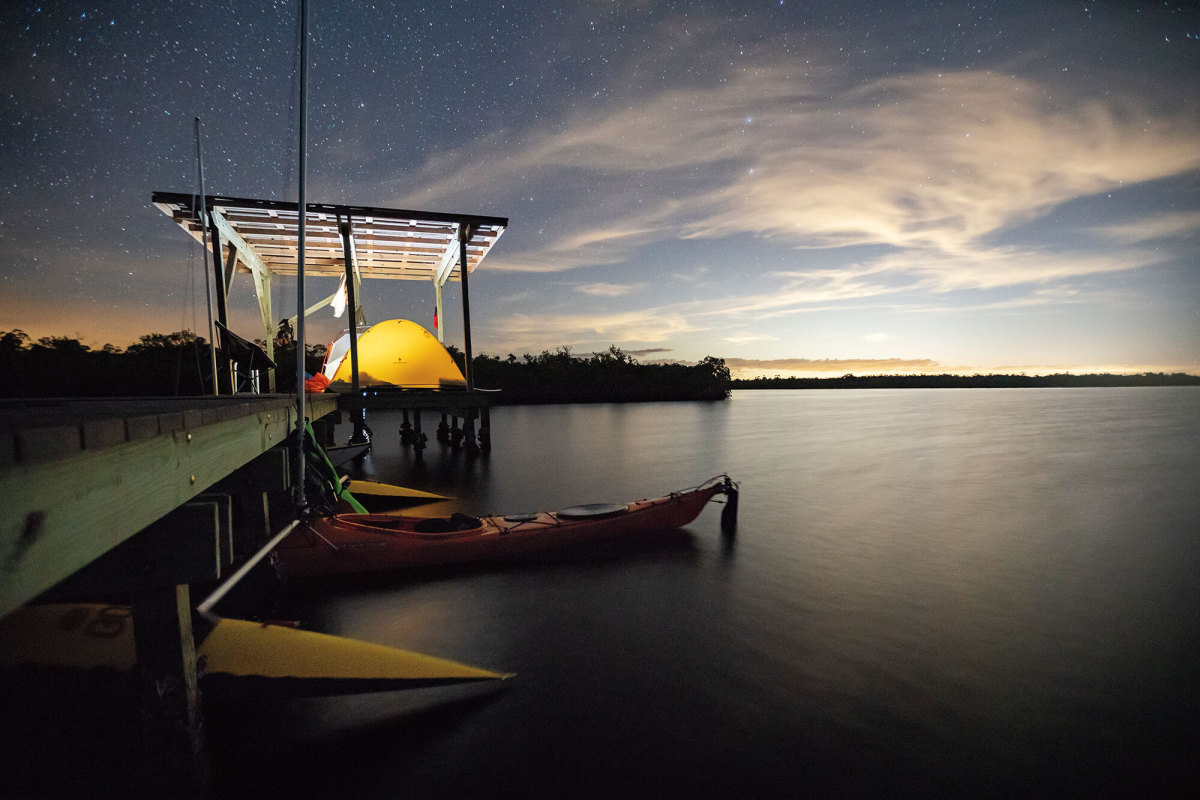
In the morning, we were elated to find the wind continued to favor our northern journey. As a sailor, I had been drawn back here in part because of what Douglas, grandmother of the Everglades, described in her book as continuous southeast trade winds that “pour across the land their cool stiff tides.”
As the sun painted the mangroves a brilliant lime, we raised our sheets, tacked out into the bay, then turned north and continued along the narrow channel. Soon enough, the wind stiffened and snapped tight against the sails.
Tarpon surfaced and rolled like bulbous snakes as wind stirred the surf. While stopping in the lee of islands, we consulted the satellites on battery-powered Garmins and tracked our progress on a waterproof map.
Always following the wind, we picked the northernmost channel out of Oyster Bay, across the Shark River delta, and out against an incoming tide that flowed into the Everglades, in the opposite direction of its once-mighty headwaters. Maps can’t keep pace with this fluctuating labyrinth of channels, so we now deferred to Greg’s Garmin, until we popped out and away from the tidal current into Ponce de Leon Bay. Somehow Chris kept us in sight as we all but flew across a bouncing sea. We reached the Graveyard Creek campsite at 3 p.m. For a park with over 1 million visitors a year—February being a prime time with over 2,000 allocated camper days—the fact we’d seen only one other canoe the entire day goes to show how vast the Glades are.
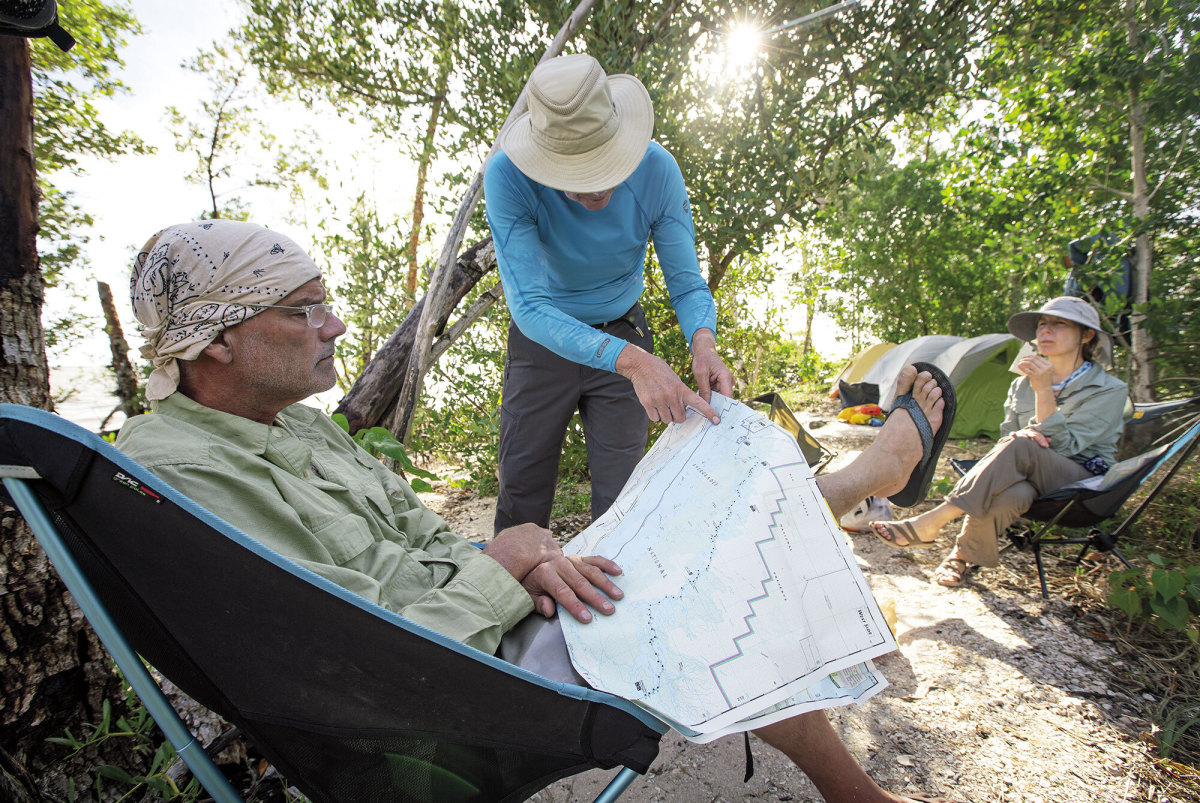
White ibis congregated on the opposite beach. Pelicans sat atop snags waiting for the tide to change. And upstream, a roseate spoonbill wagged its rounded, spatula-sized mandible underwater—the creature stood as an otherworldly pink presence in the shadowed tunnel. If these wading birds, indicators of the ecosystem’s overall health, ever disappear, it’ll mean that the drying Everglades too—along with all the bird habitat—are finally dead.
Swatting at the mosquitoes in a chair, I wrote in my journal, “It’s an ugly campsite surrounded by a beach of quicksand silt that will give us trouble leaving in the morning at low tide, but it is the heart of the EGlades, alive with who knows how many insects and dense, totally unwalkable terrain. With prolific sharks and large reptiles, to swim it you’d be giving your life away. In other words, it’s glorious wilderness.”
Despite any requisite suffering that you must first pass through, wild places are a balm for the soul, where we can leave our information age behind and reconnect with the primeval. I go, in part, for the challenge of navigating the infinite, for the joy of mastery in boating or climbing or skiing. But mostly I go to watch the stars bright above the treetops in a world where we can breathe clean air and revel about the wind on our faces while we connect with wildlife in the visceral, intuitive way that our hunting ancestors once did. I have sought out the joys of remote spaces while boating source to sea on the Colorado River, paddling across the Northwest Passage, climbing Denali in the wintertime, and sailing the Pacific. But when I learn of wilderness at risk—in a wetlands as treasured and unique as the Everglades—I feel that a piece of our American heritage is being violated. This protected acreage belongs to everyone as a democratic right, to be preserved in perpetuity for future generations. So, if we continue destroying the Everglades, the congressional mandate of preserving national parks will become meaningless.
The wind dropped and the setting sun doused itself into the Gulf. Then I plunged into my own internal twilight as biting midges arrived in gray clouds, impervious to insect repellent, burrowing under our bandanas and hats. While the mosquitoes of the Arctic and the blackflies of New England merely require a Buddhist calm, the onslaught of what South Floridians call sandflies—their minute teeth sawing tiny, burning cuts into your skin, possibly transmitting parasites—force retreat to shelter.
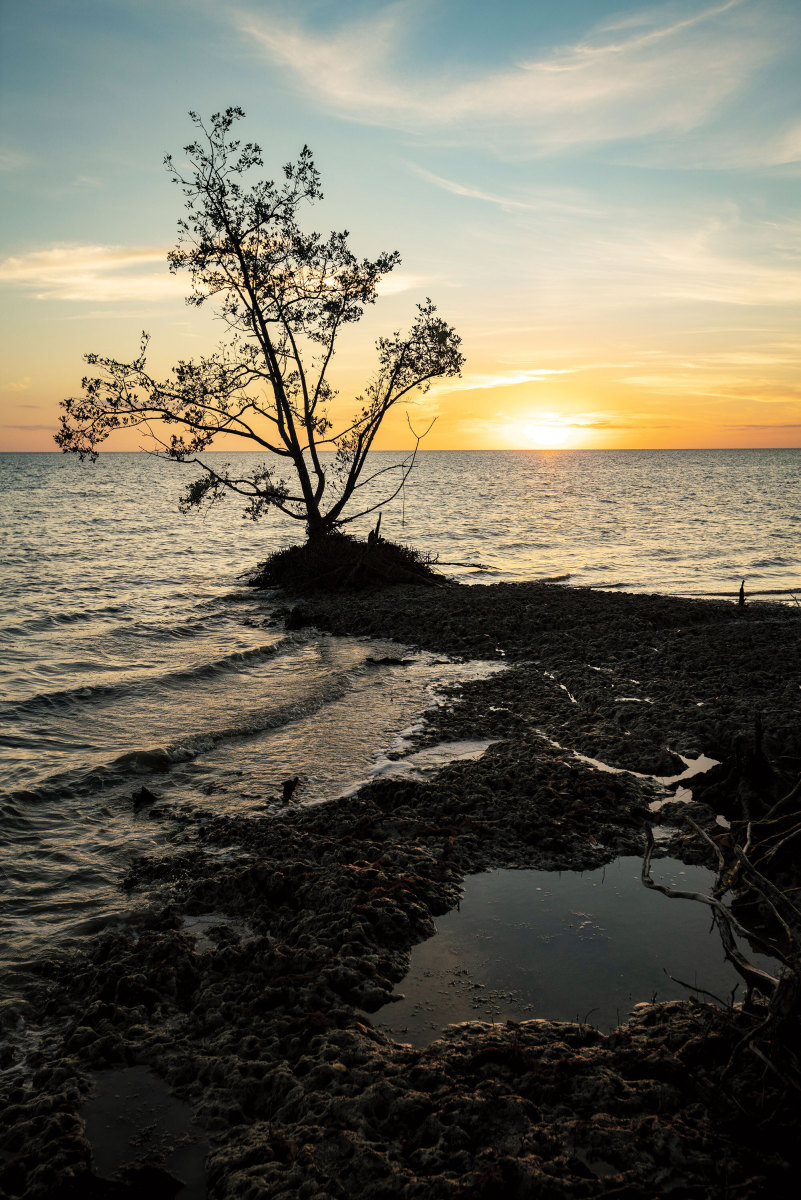
Like most evenings here before bedtime, I spent 15 minutes crushing insect guests against nylon walls, wondering how the Dalai Lama—famous for sparing bugs—would survive the night. Even the tireless enviro-crusader Douglas preferred breezy picnics to camping in the world’s foremost swamp. “It’s too buggy, too wet,” she wrote, “too generally inhospitable.”
Thirty yards away, the imperturbable Chris tried to escort his winged guests out of the tent. Yet he, too, was happy to be here, in his comfort zone and no longer worried about reptiles (the smallish American crocodile, after all, is not a man-eater). Until now, he had journeyed to places of roaring water and abrupt geography that required split-second decision making in his kayak. But in Florida, amid an all-encompassing flatness, he was stricken by this vast land, half-immersed by water. The Everglades demand nothing less than all of your awe.
On our fifth day out, sailing in sight of the Ten Thousand Islands at the northwestern edge of the park, loggerhead turtles popped their softball-sized heads up, grinned, then ducked back under as we passed.
Somewhere beneath me, too, would be manatees and more than a dozen species of sharks. I pulled my trailing hand out of the tropical water and back into the cockpit. Just then, a curious bottlenose dolphin dared to approach my outrigger and exhale a spumy pong that smelled as rich as low-tide mud beaches.
We patiently plied the dying southern trade, as we worked our paddles beneath the sail and kept our northern course. To starboard, we studied the nearly 1.3 million acres of Marjory Stoneman Douglas Wilderness (amid another 200,000 acres of national park). Piles of dead seagrass lay mounded up on the beaches. Beyond the impenetrable mangrove hedge, the area had been further safeguarded (after it had already been made a park) by Congress under the 1964 Wilderness Act. To protect its rich biodiversity, this wilderness area is intended to remain bereft of improvements, preserved solely in its natural conditions— despite a jet from a nearby military base repeatedly thundering through the sound barrier above us.
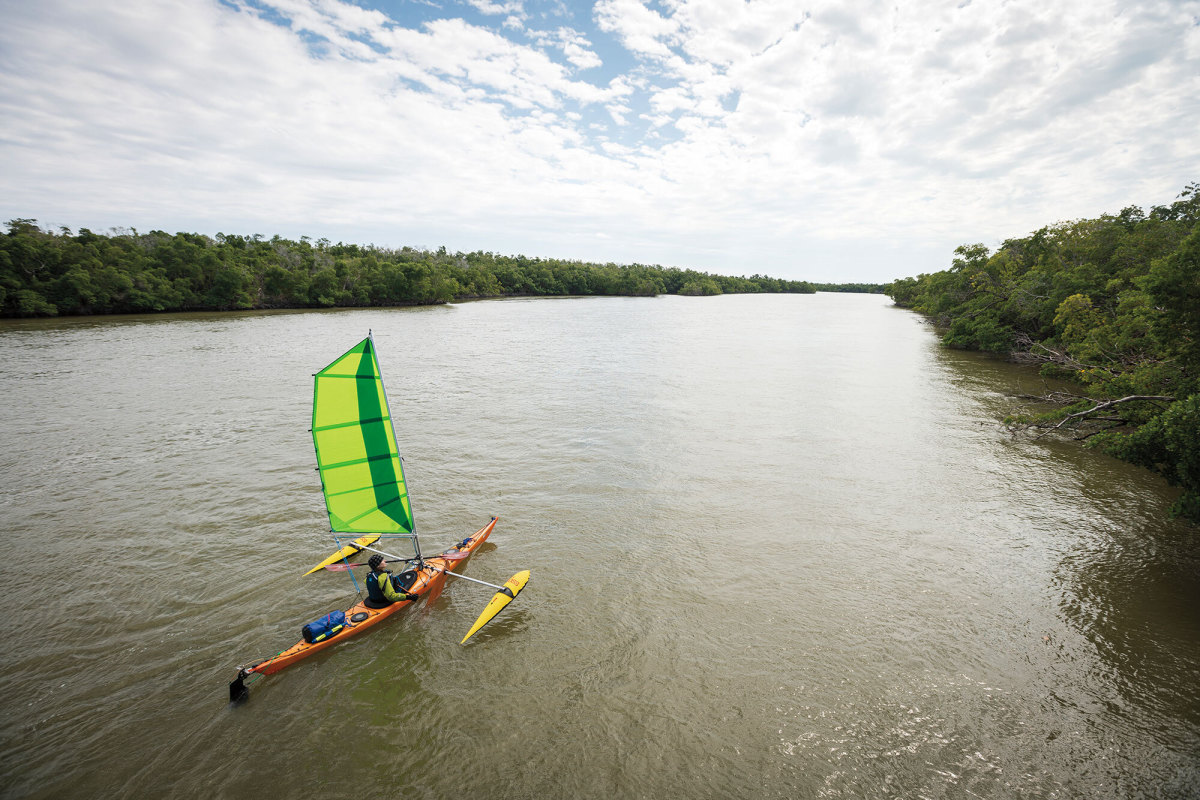
Even in the wildest reaches of the Everglades, it’s difficult to leave civilization totally behind. After listening to news of an incoming storm on Greg’s weather radio, we opted to speed up our trip and move farther north to Jewel Key. We pulled up to an idyllic beach after a pleasant seven-hour sail. In pellucid waters, seemingly free of predators, I stripped down and took the week’s first bath, protectively cupping the family jewels—just in case.
While watching an osprey carry a fish to its nest, a park service motorboat landed on the beach and broke our reverie. Out stepped a uniformed ranger, stiff and nervous, the antithesis of Lincoln Vail, demanding to see our backcountry permit. I explained we had switched campsites because of the incoming storm, but the ranger was only interested in the letter (rather than the spirit) of the law. It would cost us $105. My years of service in the parks meant nothing to this armed and obnoxious policeman.
Nor did the three illegal campfire scars he stood next to on the beach. After he left, I chucked the toasted coral back into the sea and spread out the ashes. Then we gathered driftwood for a (legal) campfire down in the littoral that would be flushed clean by high tide.
As the north wind fanned sweet smoke from our burning mangrove logs, I knew that all of this—the Milky Way phosphorescing above us, our days working the wind while watching birds, and even the exceptional bugs—had drawn me back to the swamp after so many years.
And through experiencing the unexpected resilience of its animals, along with the dizzying wonder of its many plant species, I believe it should be saved as something wilder and more sacred than an artificial “Disneyland Everglades” (as an Army Corps official has called it). And he may be right, at least partially, because we’ll never get back the pre-contact Everglades. While the wetlands are now less than half of what they used to be, we still have an obligation to save what remains, not contrive some type of theme park. After all, this is legislated wilderness. We’re already committed.
To restore the River of Grass, it’ll take more than just political will. The most pressing issue is regular funding that would infuse 17 different uncompleted CERP projects, such as a planned reservoir just south of Lake Okeechobee, to hold and release water into the wetlands during the dry season. Since the $8 billion program began in 2000 as a 30-year plan, CERP has now become a 50-year, $15 billion dream.
Still, there is hope, given the science and engineering behind CERP. If the Corps can replumb the Everglades and bring back its freshwater head (the River of Glades) from the north, it would create a backpressure to stave off the storm surges and ocean rise in the south—now beginning to salinate both the wetlands and the freshwater aquifers sustaining millions of Floridians.
There are other issues at hand too, such as tens of thousands of Burmese pythons slithering among the Glades as one of over 100 different invasive plants and animals pushing out indigenous species. To cope and support restoration, we need a fully funded park service with leadership that’s more interested in resource management than overzealous law enforcement. We also need everyone to understand how the clock is now running out on America’s most extraordinary wetlands.
We need to heed the words of Marjory Stoneman Douglas: “There are no other Everglades in the world.”
As the squall hit Jewel Key after dark, my companions shouting back at a violent wind gust, it seemed epiphanic how this swamp that belongs to all of us offered up the same sense of surprise and allure I had felt as a boy. And in the half-century that had passed, I have never seen another wilderness like it.
I dove into the tent, flattened by the wind, turned on a headlamp and braced the walls with my arms. Not an insect guest to be found.
from Men's Journal https://ift.tt/2ZTxjKU
via IFTTT


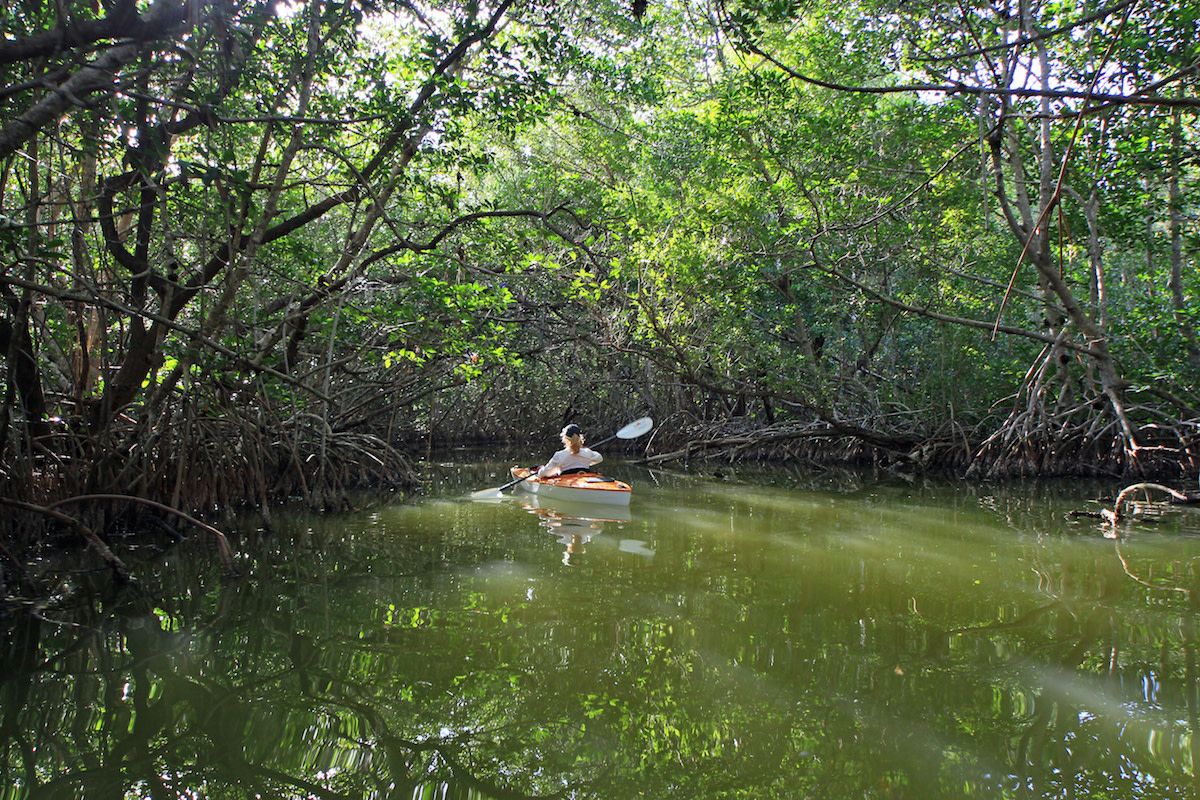









0 comments:
Post a Comment